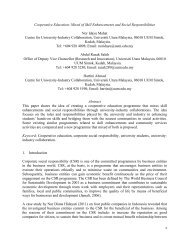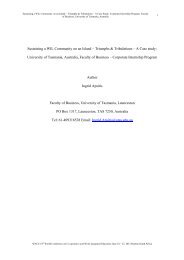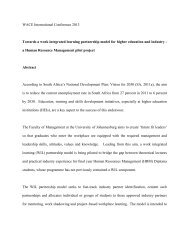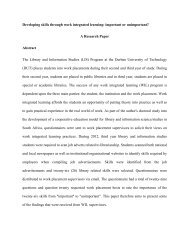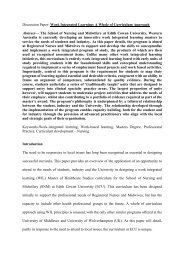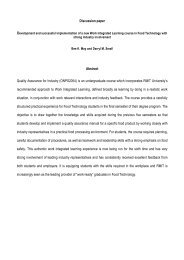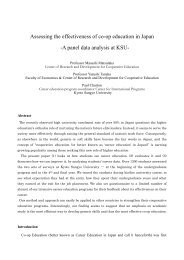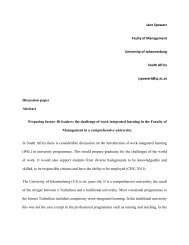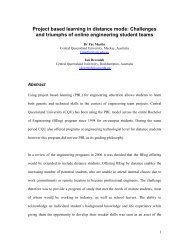Pieter van Brakel, Cape Peninsula University of Technology ... - WACE
Pieter van Brakel, Cape Peninsula University of Technology ... - WACE
Pieter van Brakel, Cape Peninsula University of Technology ... - WACE
- No tags were found...
Create successful ePaper yourself
Turn your PDF publications into a flip-book with our unique Google optimized e-Paper software.
9 th International Conference onCooperative and Work-integrated Education20-22 June 2012Istanbul, TurkeyStudent exposure to knowledge sharing processes duringwork-integrated learningPr<strong>of</strong> <strong>Pieter</strong> <strong>van</strong> <strong>Brakel</strong><strong>Cape</strong> <strong>Peninsula</strong> <strong>University</strong> <strong>of</strong> <strong>Technology</strong><strong>Cape</strong> Town, South Africa<strong>van</strong>brakelp@cput.ac.zaINTRODUCTIONIt is generally accepted that the purpose <strong>of</strong> higher education is to prepare students orlearners to perform effectively and efficiently in the complex world <strong>of</strong> ‘work’. It isassumed that ‘work-integrated learning’ or WIL should prepare a student for the social,pr<strong>of</strong>essional and working environments that they will enter after successfully attendingan institute <strong>of</strong> higher education. Furthermore, work practices can only be learnedthrough the experience <strong>of</strong> practising with other practitioners. It is in this context thatRaelin ( 2007:499) identifies the following building blocks <strong>of</strong> a so-called epistemology <strong>of</strong>practice:Critical reflection: the thinking capacity to make sense <strong>of</strong> practitioners’ ownpractice and experiences; the ability to think about how their actions resulted in aparticular outcome.Mastery: developed through an appropriate apprenticeship in which the novice isexposed to multiple practices.Extensive use <strong>of</strong> tacit knowledge: the tacit (intangible) thinking processes thatpractitioners use as they solve problems and challenges <strong>of</strong> daily practices.The third element forms the focus <strong>of</strong> this paper, namely that as we introduce throughWIL the student to the practical activities within an organisation, they should alsobecome acquainted with the knowledge generation processes within an organisation.This does not entail knowledge management as such, but implies the ultimate practiceas can be found in the term knowledge sharing.Effective knowledge sharing has developed into an important priority to enterprise, notnecessarily because <strong>of</strong> the importance <strong>of</strong> knowledge to knowledge workers, butbecause <strong>of</strong> the increasing acceptance that tacit knowledge adds more value thanexplicit knowledge to the innovation process (Marouf 2007:11). There is generalconsensus that <strong>of</strong> the many resources an organisation may apply, knowledge isaccepted as a key differentiator, therefore crucial to any organisation’s competitivead<strong>van</strong>tage.
Ability or skill to solve a problem which is partly based upon one’s ownexperience and learning Subjective and known only to the individual Highly personal and difficult to formalise Based upon actions and experiences <strong>of</strong> the individual If expressed, it can take the form <strong>of</strong> analogies, metaphors, stories or personalstrategies <strong>of</strong> the individual.To summarise, the following interaction features are typical <strong>of</strong> tacit knowledge (Holsteand Fields 2010:130):Face-to-face interaction is <strong>of</strong>ten the primary method for sharing tacit knowledge.Levels <strong>of</strong> risk and uncertainty typically associated with tacit transfer are reducedby trust in relationships (see the topic <strong>of</strong> trust in an enterprise below).Key to formal and informal tacit knowledge transfer is the willingness andcapacity <strong>of</strong> individuals to share what they know.For those who want to probe further into this matter, a detailed outline <strong>of</strong> the writing <strong>of</strong>various authors about tacit versus explicit knowledge is to be find in an extensive tablecompiled by Holste and Fields (2010:130).To conclude this section one has to emphasise that Web 2.0’s social networking andsocial media developments have not only resulted in a more effective and productivetacit knowledge sharing but will also have a major influence on WIL.Knowledge managementA knowledge management system provides for both tacit (uncodified) and explicitcodified knowledge to be created, stored and shared with ICT technology (Harlow2008:150). The following list <strong>of</strong> critical knowledge processes is a summarised by thesame author:Generation <strong>of</strong> new knowledgeAccessing valuable knowledge from outside sourcesSuing accessible knowledge in decision-makingEmbedding knowledge in processes, products and servicesRepresenting knowledge in documents, databases and s<strong>of</strong>twareFacilitating knowledge growth through culture and incentivesTransferring existing knowledge into other parts <strong>of</strong> the organisationMeasuring the value <strong>of</strong> knowledge assets, thus the quality <strong>of</strong> the organisation’sknowledge management.Suppia and Sandhu (2011:464) list a number <strong>of</strong> rele<strong>van</strong>t sources to conclude thatknowledge management describes the following activities:Managerial and administrative processes <strong>of</strong> knowledge management, which caninclude the following:Knowledge assessmentKnowledge acquisition, absorption and assimilationKnowledge creation, processing, development, transformationKnowledge storage and retrievalKnowledge sharing, distribution, circulation, transfer
Type <strong>of</strong> training: New employees and the transfer or promotion between varioussections necessitates proper training. This is typically done by formal classes,consisting <strong>of</strong> presentations by instructors and supported by documentation suchas notes on rules, procedures and processes. These mainly support sharing <strong>of</strong>explicit knowledge. The rele<strong>van</strong>t indicator in this regard refers to the extent towhich an organisation also make provision for more tailored strategies basedupon personal contact such as coaching and mentoring, which obviouslydemands more time.Knowledge storage: This is a demanding aspect to prioritise as investment ininformation technology is not appropriate for explicit knowledge sharing (eginvestments in sophisticated database systems). Tacit knowledge sharing investsin the accumulated experience <strong>of</strong> its employees, as knowledge is directly relatedto the person who developed it. This indicator will establish to what extentorganisational knowledge is effectively stored in its people.Power: The possibility <strong>of</strong> loss <strong>of</strong> power <strong>of</strong> those who share willingly what theypossess is a well-known phenomenon. ‘Knowledge is power’ is contradicted withsharing as it can mean loss <strong>of</strong> influence, superiority pr<strong>of</strong>essional respect andeven job security. An important indicator is thus an analysis <strong>of</strong> the knowledgewith regard to it as a source <strong>of</strong> power within the organisation.Internal level <strong>of</strong> questioning: Employees who get to know each other develop arelationship <strong>of</strong> trust among themselves, therefore can deal better with conflictsand differences, thereby enriching corporate knowledge. In this context thecritical indicator should be the level <strong>of</strong> questioning and criticism tolerated withinan organisation.Type <strong>of</strong> valued knowledge: Some forms <strong>of</strong> tacit knowledge such as intuition andpersonal skills are sometimes not considered <strong>of</strong> value by traditional organisationsand their workers. This is a barrier that can prevent the sharing and building <strong>of</strong>tacit knowledge within an organisation. This is contradictory <strong>of</strong> what is generallyaccepted in the modern enterprise, namely sharing <strong>of</strong> personal tacit knowledge.A knowledge sharing indicator should therefore be to establish the acceptance <strong>of</strong>by employees <strong>of</strong> suggestions and ideas that are not supported by data and facts.Media: Choice <strong>of</strong> media used by an enterprise can contribute to tacit knowledgetransfer. Personal communication, demonstration <strong>of</strong> personal skills and evenbody language is regarded as ‘rich’ ways <strong>of</strong> communication, in contrast withexplicit knowledge where immediate feedback is invariably not possible.Establishing the most commonly used ways <strong>of</strong> communication betweenemployees is the indicator for effective tacit knowledge sharing.The above-mentioned indicators will be revisited towards the end <strong>of</strong> this paper, as most<strong>of</strong> the indicators can play a role to establish an environment in industry (workstations)which has the potential to expose a student to a knowledge sharing experience.Furthermore, Web 2.0 technology and its associated tools bring about a new approachor model namely KM 2.0, which represents an effort to harness the collectiveintelligence <strong>of</strong> a company through formal and informal communication by making use <strong>of</strong>social networking and social media (Razmerita, Kircher & Sudzina 2009:1033).
Knowledge sharingAs said above, the purpose <strong>of</strong> this paper is to emphasize the necessity to undergoquality experience in industry with regard to knowledge sharing. The latter is the mainoutflow or result <strong>of</strong> effective albeit informal knowledge management in the typical smalland medium enterprise. As with the other essential key terms or concepts as discussedabove, the term knowledge sharing was and still is being scrutinized. Herewith aselected number <strong>of</strong> definitions, selected to be rele<strong>van</strong>t to the knowledge sharingexperiences during WIL:Knowledge sharing is the act <strong>of</strong> an employer dispersing his/her obtainedknowledge and information to other colleagues within an enterprise (Ryu, H &Han 2003) 1 as quoted by Lin, Hung & Chen (2009:930).Chua (2003:118) defines knowledge sharing as the process by which individualscollectively and iteratively refine a thought, an idea or a suggestion in the light <strong>of</strong>experiences.Knowledge sharing is a process <strong>of</strong> communication between two or moreparticipants with regard to the provision and acquisition <strong>of</strong> knowledge (Lin, Hung& Chen 2009:930).Knowledge sharing is more than transferring information; it is instead theprovision or receipt <strong>of</strong> task information, know-how- and feedback about a productor procedure (Mueller 2012:4).To conclude, it can therefore been said that knowledge sharing requires that aperson first share knowledge to others, thereafter the group achieves mutualbenefits.Some challenges would be addressed if an organization plans to fully incorporateknowledge sharing in a WIL situation. Possibly the most important reason is that tacitknowledge, the subject for sharing is intangible and as seen in the previous list, sharingoccurs specifically between two individuals or within a group.Knowledge sharing and organizational cultureThere is sufficient evidence in the literature tacit knowledge sharing is dynamicallylinked or attached to the people in the organization. These can be the employees, theleaders and the managers <strong>of</strong> enterprises. Furthermore, quite a few studies have beenpublished on the influence <strong>of</strong> organizational culture on the quality <strong>of</strong> knowledge sharing;see for example Figure 1 for a useful model as developed by Suppiah and Sandhu(2011:466).The fundamental departure point <strong>of</strong> the model is that ‘…the various dominant culturetypes influence tacit knowledge sharing behaviour differently – some positively andothers negatively (Suppiah & Sandhu 2011:466). For establishing an efficient WILenvironment with regard to organization culture, it is therefore essential to identify theculture types present in an organization; Figure 1 classifies them as follows (pp 467):1. Clan culture: a friendly environment where people share a lot about themselves;typical features are teamwork, employee involvement programmes, highemployee commitment to enterprise and fellow workers, as well as highcorporate commitment to employee.1 Rya, S., Ho, S.H. & Han, I. 2003. Knowledge sharing behaviour <strong>of</strong> physicians in hospitals. ExpertSystems with Applications 25(1):113-122.
Result: clan culture has a positive influence on tacit knowledge sharing.2. Adhocracy culture: generally organic and characterised by a dynamic ,entrepreneurial and creative workplace. Knowledge workers are empowered andtaking risks is encouraged. Leadership is innovative and risk-orientated.Result: has also a positive influence on tacit sharing.3. Market culture: major focus <strong>of</strong> this culture is to conduct transactions with otherstakeholders to develop competitive ad<strong>van</strong>tage. Competitiveness andproductivity is the foundation <strong>of</strong> such a market culture. Also: winning is everythingin a market culture. Knowledge therefore becomes a proxy for power.Result: has a negative impact on tacit sharing behaviour.4. Hierarchy culture: characterised and multiple hierarchical structures, with aminimal powers vested in employees.Result: has a negative influence on tacit knowledge sharing behaviour.5. No dominant culture type: two or more cultures may appear simultaneously.Result: depending on the combination: if negative culture then a negativeinfluence will avail; opposite also true.Figure 1: Theoretical model illustration the potential influence <strong>of</strong> organisationalculture on tacit knowledge sharing (Suppiah and Sandhu 2011:466)
Culture types 1 and 2 are therefore strongly recommended for WIL; research is stillnecessary to establish how to select these two types for work-integrated learning.Furthermore, it is a reality that the ‘younger generation’ are already using tacitknowledge sharing tools via the Web – albeit intuitively they expect them to be availablein the workplace, and secondly they find it natural to use (Levy 2007:129).They are bynow well-equiped for Web 2.0 and Enterprise 2.0 functionalities to be implemented inthe corporate environment.To conclude this section the work by Holste and Fields (1020:129) on trust and tacitknowledge sharing is <strong>of</strong> the utmost importance. They argue that the willingness <strong>of</strong>employees to share and use tacit knowledge may depend on the extent that knowledgeworkers are trusted recipients and sources. Although untested, this may just as welllead to the conclusion that trust per se would experience greater visibility in the clan andadhocracy culture groups mentioned above.Typical knowledge sharing technologiesFormal and industry-based knowledge sharing technologies or knowledge sharingenablers can add tremendous value to an enterprise (Hedgebeth 2007:49). The sameauthor also identifies six categories <strong>of</strong> KM technologies, such for collaboration, mobilework, content management, business intelligence, business process management, aswell as for knowledge sharing. Research is still to be done, but it is only logic to arguethat these formal company-wide and industry-based technologies will soon gave way fora much more informal social networking and/or social media approach. Again, theyounger generations will demand a type <strong>of</strong> corporate Facebook or similar networksystem. In this context Gotta made some inroads in reporting on his empirical work(2009:10). He founded inter alia that wikis might be an important option for building acommunity or type <strong>of</strong> virtual community site. The latter is a common starting point andmight be a huge knowledge sharing asset in the corporate years to come.Although there are an increasing variety <strong>of</strong> Web 2.0 services available, some <strong>of</strong> themcan support tacit knowledge sharing in a WIL environemt better than others. Thefollowing represents a basic list <strong>of</strong> possibilities with a brief interpretation <strong>of</strong> eachpotential role to enhanceWIL (Van Zyl 2009:908; Dickson 2010:471; Levy 2009:124;Razmerita 2009:1028-1029; Grace 2009:64-66):Really Simple Syndication (RSS): A web feed used to publish frequently updatedcontent.Tagging: Use <strong>of</strong> keywords to track contents on websites; this can be seen as aform <strong>of</strong> social bookmarking where a reader can gain access to content identifiedby other users.Social bookmarking: a system that allows readers to post their lists <strong>of</strong> bookmarksor favourite websites for others to search.Wikis: These can be described as a type <strong>of</strong> website that allows collaboration frommultiple readers who are permitted to edit a particular section’s content. Morespecifically, a wiki is a collection <strong>of</strong> contributions sharing the same templtes.
Blogs: Blogs are a self-publishing tool where the owner can periodically addcontent; readers can subscribe, link to it, share links and even add to the content.In other words, blogs are web pages consisting <strong>of</strong> user-supplied content inchronological order. Many students have already created and are maintainingtheir own blogs for various reasons, for example as a personal diary.The next section will deal with decisions to be made to with regard to selectingapplicable workstations for WIL-related knowledge sharing.CONCLUSIONThe purpose <strong>of</strong> this paper was to introduce the importance <strong>of</strong> tacit knowledge sharing inan organisation or specifically the enterprise. Secondly, Web 2.0 social media looks likethe ideal activator to improve sharing activities within the said organisation.It can be recommended that this subject area should become a high priority in the WILapproach to practical teaching and learning. Research is therefore needed to establishhow Web 2.0 technologies will result in the best knowledge sharing experiences in WIL,and secondly what are the critical indicators for WIL workstations. These are brieflydiscussed below.Wikis: It has been indicated above that Web 2.0 might provide answers to questionswith regard to how an enterprise should be structured to enhance knowledge sharing.Also, how they have been managing their knowledge assets by tapping into expertise <strong>of</strong>their own employees, suppliers and customers. By maintaining an enterprise Wiki, astudent can tap into and take part in knowledge sharing whilst busy with a WILprogramme. As indicated above a Wiki is an open accessible community <strong>of</strong> usersresponsible for its own content creation and communication.Critical indicators for WIL workstations: Possible organisations or workstations aretypically evaluated for providing good learning experiencing during the WIL phase. Fromsome indicators should be valuable to use to enable the WIL coordinator to select thebest knowledge sharing organisations possible. From Jola’s discussion <strong>of</strong> indicators thefollowing could be explored further for this purpose (2010:413-416); take note that notall <strong>of</strong> these would be rele<strong>van</strong>t to WIL needs:Individual management <strong>of</strong> time (whether knowledge workers have enough time toshare their tacit knowledge).Common language (that knowledge workers in an organisation have the abilityand (technical) opportunities to express the tacit knowledge they have acquired).Mutual trust (high level <strong>of</strong> trust among individuals facilitating tacit knowledgesharing within the organisation).Relationship network (knowing those colleagues who have the knowledge that isneeded, as well as bringing them in touch with those that might need suchknowledge).
Hierarchy (accessibility to people who possess and share tacit knowledgenotwithstanding their hierarchical position).Reward (establish if a reward system is in place for those that <strong>of</strong>ten and willinglyshare their tacit knowledge among its members).Type <strong>of</strong> training (organisations which also make provision for tailored strategiesbased upon personal contact such as coaching and mentoring).Knowledge storage (establish to what extent organisational knowledge iseffectively stored in its people).Power (analysis <strong>of</strong> the knowledge with regard to it as a source <strong>of</strong> power withinthe organisation).Internal level <strong>of</strong> questioning (level <strong>of</strong> questioning and criticism tolerated within anorganisation).Type <strong>of</strong> valued knowledge (acceptance <strong>of</strong> by employees <strong>of</strong> suggestions andideas that are not supported by data and facts).Media (wide level and types <strong>of</strong> communication between employees indicateseffective tacit knowledge sharing).ReferencesAl-Alawi, A.I., Al-Marzooqi, N.Y. and Mohammed, Y.F. 2007. Organizational cultureand knowledge sharing: critical success factors. Journal <strong>of</strong> Knowledge Management11(2):22-42.Chua, A. 2003. Knowledge sharing: a game people play. Aslib proceedings 55(3):117-129.Dickson, A. and Holley, R.P. 2010. Social networking in academic libraries: thepossibilities and the concerns. New Library World 111(11):468-479.Gotta, M. 2009. Field research study: social networking within the enterprise.Collaboration and content strategies. Burton Group. [www.burtongroup.com]Grace, P.P.L. 2009. Wikis as a knowledge management tool. Journal <strong>of</strong> KnowledgeManagement 13(4):64-74.Hall, B.P. 2001. Values development and learning organisations. Journal <strong>of</strong> KnowledgeManagement 5(1):19-32.Harlow, H.H. 2008. The effect <strong>of</strong> tacit knowledge on firm performance. Journal <strong>of</strong>Knowledge Management 12(1):148-163.Hedgebeth, D. 2007. Making use <strong>of</strong> knowledge sharing technologie. VINE 37(1):49-55.
Holste, J.C. and Fields, D. 2010. Trust and tacit knowledge sharing and use. Journal <strong>of</strong>Knowledge Management 14(1):128-140.Joia, L.A. and Lemos, B. 2010. Rele<strong>van</strong>t factors for tacit knowledge transfer withinorganisations. Journal <strong>of</strong> Knowledge Management 14(3):410-427.Joseph, M., Firestone, J.M. and McElroy, M.W. 2005. Doing knowledge management.The Learning Organization Journal 12(2). [http://www.emeraldinsight.com/10.1108/0969647051]Levy, M. 2009. Web 2.0 implications on knowledge management. Journal <strong>of</strong> KnowledgeManagement 13(1):120-134.Lin, M.J., Hung, S. and Chen, C. 2009. Fostering the determinants <strong>of</strong> knowledgesharing in pr<strong>of</strong>essional virtual communities. Computers in Human Behaviour 25:929-939.Marouf, L.N. 2007. Social networks and knowledge sharing in organisations: a casestudy. Journal <strong>of</strong> Knowledge Management 11(6):110-125.Mueller, J. Knowledge sharing between project teams and its cultural antecedents.Journal <strong>of</strong> Knowledge Management 16(3):4-21.Raelin, J.A. 2007. Toward an epistemology <strong>of</strong> practice. Academy <strong>of</strong> ManagementLearning and Education 6(4):495-519.Razmerita, L., Kircher, K. and Sudzina, F. 2009. Personal knowledge management: therole <strong>of</strong> Web 2.0 tools for managing knowledge at individual and organisational levels.Online Information Review 33(6):1021-1039.Schneckenberg, D. 2009. Web 2.0 and the empowerment <strong>of</strong> the knowledge worker.Journal <strong>of</strong> Knowledge Management 13(6):509-520.Suppia, V. and Sandhu, M.S. 2011. Organisational culture’s influence on tacitknowledge sharing behaviour. Journal <strong>of</strong> Knowledge Management 15(3):462-477.Van Zyl, A.S. 2009. The impact <strong>of</strong> social networking 2.0 on organisations. TheElectronic Library 27(6):906-918.END



